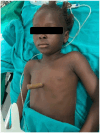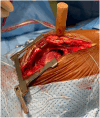Right ventricle pierced by a traditional sharp hair straightener: a case report
- PMID: 38879595
- PMCID: PMC11179380
- DOI: 10.1186/s13019-024-02770-3
Right ventricle pierced by a traditional sharp hair straightener: a case report
Abstract
The case presents a traumatic ventricular perforation of a girl, accidentally felt on a sharp instrument. The uniqueness of the case presented is due to the very high infrequency of injuries with this type of sharp object. The 7-year-old girl was transported to the hospital after accidentally falling on a sharp instrument. The child had no signs of heart failure. On opening the chest, it was found that the metal object was lodged in the right ventricle. Quickly proceeded to remove the object and suture the entry hole. After a short hospitalization, the child was discharged completely cured.
Keywords: Cardia foreign body; Case report; Chest trauma; Right ventricle.
© 2024. The Author(s).
Conflict of interest statement
The authors declare no competing interests.
Figures
Similar articles
-
An unusual penetrating shrapnel in the heart.Asian Cardiovasc Thorac Ann. 2022 Feb;30(2):208-210. doi: 10.1177/0218492321996512. Epub 2021 Feb 22. Asian Cardiovasc Thorac Ann. 2022. PMID: 33611929
-
[Penetrating trauma by foreign body in the left heart ventricle].Rev Esp Cardiol. 1997 Feb;50(2):137-9. doi: 10.1016/s0300-8932(97)73193-2. Rev Esp Cardiol. 1997. PMID: 9092002 Spanish.
-
Trans-sternal cardiac injury caused by a hooked needle.Emerg Med J. 2005 Oct;22(10):751-3. doi: 10.1136/emj.2004.014779. Emerg Med J. 2005. PMID: 16189049 Free PMC article.
-
Left ventricle injury with a normal pericardial window: case report and review of the literature.J Trauma. 2007 Aug;63(2):414-6. doi: 10.1097/01.ta.0000246954.25883.db. J Trauma. 2007. PMID: 17693845 Review. No abstract available.
-
Penetrating trauma of the heart.Semin Thorac Cardiovasc Surg. 1992 Jul;4(3):203-8. Semin Thorac Cardiovasc Surg. 1992. PMID: 1498198 Review. No abstract available.
References
-
- Yamasawa T, Kanaoka Y, Furusawa K, Yamane N, Tamura T, Kuwada N, Watanabe Y, Yunoki Y, Tabuchi A, Tanemoto K. Treatment of ventricular septal perforation caused by blunt trauma using the right ventricle approach: a case report. J Cardiol Cases. 2021;24(4):153–6. doi: 10.1016/j.jccase.2021.03.004. - DOI - PMC - PubMed
-
- Degiannis E, Loogna P, Doll D, Bonanno F, Bowley DM, Smith MD. Penetrating cardiac injuries: recent experience in South Africa. World J Surg. 2006;30(7):1258-64. 10.1007/s00268-005-0463-5. PMID: 16773259. - PubMed
-
- Bassetti M, Righi E, Astilean A, Corcione S, Petrolo A, Farina EC, De Rosa FG. Antimicrobial prophylaxis in minor and major surgery. Minerva Anestesiol. 2015;81(1):76–91. - PubMed
Publication types
MeSH terms
LinkOut - more resources
Full Text Sources




